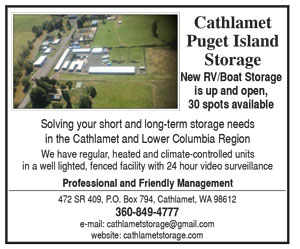F/W commission airs options on salmon harvest; delists eagles, falcons
December 15, 2016
The Washington Fish and Wildlife Commission removed bald eagles and peregrine falcons from the state list of sensitive species and received public comments on future options for the Columbia River reform policy at a meeting Dec. 9-10.
According to a commission news release the board's action to reduce the state's protective status of bald eagles and peregrine falcons reflects the species' recovery since the 1970s, when the pesticide DDT was banned under federal law.
In addition to delisting bald eagles and peregrine falcons, the commission also approved the reclassification of three other wildlife species. White pelicans were reduced from endangered to threatened status, while marbled murrelets and lynx were reclassified as "endangered" due primarily to the continuing loss of essential habitat.
The second day of the meeting was largely dedicated to a public discussion about the next phase of the commission's Columbia River reform policy, adopted in 2013 to restructure salmon fisheries below Bonneville Dam.
Developed in conjunction with Oregon, the policy is designed to promote conservation of salmon and steelhead, prioritize recreational salmon fishing in the lower Columbia River, and transition gillnet fisheries into off-channel areas. The policy also calls for increasing hatchery releases in these areas, while expanding commercial fishing opportunities through the use of alternative fishing gear.
With the transition period of the reform policy set to end this year, the commission heard comments from more than two-dozen recreational and commercial fishers on options for implementing the next phase of that plan. Initial options under consideration by the commission would:
--Extend the transition period of the current plan.
--Adopt the Oregon Department of Fish and Wildlife staff proposal for "rebalancing" commercial and recreational benefits for spring and summer chinook salmon.
--Follow the current policy, which would end the transition period Dec. 31, 2016.
Following public testimony, the commission asked WDFW staff to provide an economic analysis of each option and to analyze an additional option that would explicitly allow a gillnet fishery for upriver bright fall chinook upstream from the Lewis River in 2017 and 2018.
Options currently under consideration are posted on WDFW's website at http://wdfw.wa.gov/conservation/fisheries/lower--columbia/options.html. The commission will accept written comments on those and other proposals through Jan. 6, and will also invite public testimony at a public meeting Jan. 13-14 in Vancouver before considering any updates to the policy.
A week previous, the Oregon Fish and Wildlife Commission gave itself up to one year to complete the task, extending the deadline out to December 2017.
As reported in The Columbia Basin Bulletin, one of the sticking points for both state commissions and their fish and wildlife staffs is that the reform also promised to keep gillnetters economically whole, yet the actual plan implementation is lagging in hatchery production of smolts, identifying additional off-channel areas and developing alternative gear that would allow commercial fishers to better target hatchery fish, among other issues.
In its outline of options, the Washington commission broke out regulations and share of the mainstem catch by listed chinook salmon species.
For ESA-listed upriver spring chinook:
--Extend the transition period of the current policy used in 2016: the recreational angler share would be 70 percent and the commercial gillnetter share would be 30 percent. Tangle nets and gillnets would be allowed in off-channel areas and tangle nets would be allowed in the main channel.
--The ODFW plan would give 80 percent to recreational anglers and 20 percent to gillnetters. Non-gillnet selective gear in the mainstem river would be allowed only after the run update. Commercial impacts could include those not projected to be used by recreational anglers.
--Current policy: Impacts would be split 80 percent recreational and 20 percent commercial, but all commercial fishing will be in off-channel areas with gillnets and tangle nets.
For summer chinook:
--Extend the transition: 70 percent recreational, 30 percent commercial. Gillnets allowed in the mainstem river.
--ODFW Plan: 80 percent recreational and 20 percent commercial. Some 25 percent of impacts would be allowed for off-channel fisheries for late returning spring chinook and early returning select area brights. Some 75 percent of the impacts would be allowed for mainstem fisheries using non-gillnet selective gear and fishing techniques (these are yet to be devised or determined) that minimize bycatch impacts on sturgeon, steelhead and sockeye. If the commercial allocation is unlikely to be used, transfer the allocation to the recreational fishery upstream of Bonneville Dam or leave the allocation for spawning escapement.
--WDFW Staff Proposed Addition: Consider adding a cap on the maximum allowable release mortality rate for any mainstem commercial fishery.
--Current Policy: Not specified beyond the current transition period.
For tule fall chinook and upriver bright chinook:
--Extend the transition: 70 percent recreational and 30 percent commercial. Gillnets allowed in off-channel areas and mainstem commercial fishing allowed with alternative selective gear. If that gear is not available and practical, based on administrative, biological or economic factors, then gillnets would be allowed, but would be restricted to the area above the Lewis River.
--ODFW Plan: Not listed in the WDFW staff information.
--Extend the transition: 80 percent recreational, 20 percent commercial. Gillnets allowed in off-channel areas and in the mainstem with alternative selective gear.
For alternative selective gear, the Washington Commission will seek funding to develop and test the gear and devise a way to provide incentives to commercial fishers to promote the transition to the gear.










Reader Comments(0)